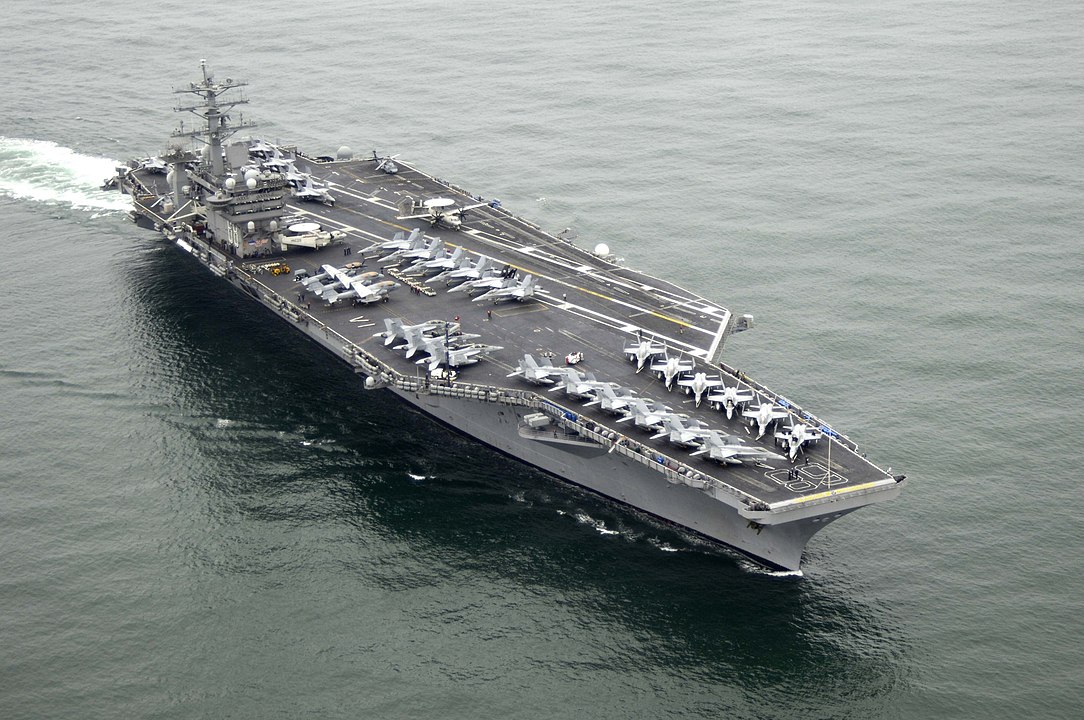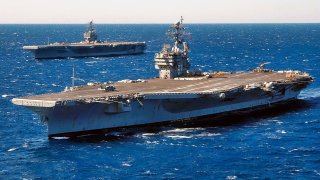Nimitz-Class Aircraft Carrier: How Fast Can It Go (Or Flank Speed)?
The top speed or flank speed of the U.S. Navy's Nimitz-class nuclear-powered aircraft carriers remains somewhat of a mystery, with official figures stating they can exceed 30 knots.
Summary and Key Points: The top speed or flank speed of the U.S. Navy's Nimitz-class nuclear-powered aircraft carriers remains somewhat of a mystery, with official figures stating they can exceed 30 knots.
-It is believed they can reach up to 31.5 knots, fast enough to cover a large area quickly.
-According to firsthand accounts, it takes around 10 minutes for these massive 97,000-ton warships to reach flank speed, and while no one has officially attempted to water ski behind an aircraft carrier, it would be possible given their impressive speed.
How Fast Can U.S. Navy Aircraft Carriers Really Go?
The United States Navy's largest vessels are also among the fastest surface combatants in service today – the question however is exactly how fast the nuclear-powered Nimitz-class super carriers can travel. Officially the United States Navy will only state that its carriers can exceed 30 knots, but how much remains unknown.
It is known that the Nimitz class was designed to produce 260,000 shp, while there is speculation the design speed was 31.5 knots – fast enough to get out of harm's way.
As Forbes.com reported in 2019, "Because they can sustain speeds of 35 miles per hour, the Nimitz-class carriers populating the current fleet can move to anywhere within a 700-square mile area within 30 minutes. After 90 minutes, that area grows to over 6,000 square miles."
Reaching Flank Speed
However, it should be noted that warships aren't always operating at "flank speed," the vessel's maximum, and it takes time to get a 97,000-ton warship moving. Recently a tactical officer shared some insight on the 'flank speed' of the U.S. Navy's supercarriers on the Quora social messaging platform.
Ross Hall, tactical action officer and anti-submarine officer assigned to a U.S. Navy Nimitz-class nuclear-powered supercarrier offered insight on the subject and was quoted by TheAviationGeekClub.com.
"It's hard to imagine what a carrier doing flank speed is like," Hall explained in his post. "During our transit to the North Arabian Sea, we conducted a rendezvous in the Indian Ocean with an amphibious group that was transiting back to the US. That day, the amphib guys showed off their LCACs, and we gave them an impromptu air show, with a couple of fly-bys for good measure."
Hall added, "As we parted company, our skipper announced 'Let's show them what an aircraft carrier can do'. We were barely making way at the time. He ordered us to depart at flank speed," noting, "When flank speed is ordered, power is applied to the shafts to turn the propellers. On the Nimitz class carriers, the four propellers are approximately 25 feet in diameter, and each weighs about 30 tons. When power is applied, torque on the shafts is limited to prevent damage – the shafts can 'twist' up to one and a half times (540 degrees). The longest shafts are 184 feet long.

"When the propellers start to turn, the water behind the ship begins to churn – it looks like the sea is beginning to boil. You can feel the ship vibrating as the engines ramp up and the propellers start to rotate," his comments continued.
The naval officer said it took about 10 minutes for the warship to reach flank speed, and he added, "If you have a long enough cable and a death wish, you could waterski behind the carrier."
Could you Water Ski Behind an Aircraft Carrier?
While Hall was clearly joking, he may not have known that in 1986, Royal Navy sailors attempted to water ski behind the Type 42 destroyer HMS Nottingham while deployed to the Persian Gulf. However, that vessel was only capable of reaching a top speed of 18 knots – about half that of the U.S. aircraft carrier.
Images have also circulated online that show the Royal Navy's Lieutenant Commander Nigel Williams water skiing from the Type 22 frigate HMS Brave in the 1980s. Yet, to date, there are no reports that any sailors have actually tried to water ski behind a carrier, yet it could be easily done by more experienced water skiers.
The average water skiing speed is about 26 knots, but for the record, according to Guinness World Records, "The fastest water skiing speed recorded is 230.26 km/h (143.08 mph) by Christopher Michael Massey (Australia) on the Hawkesbury River, Windsor, New South Wales, Australia on 6 Mar 1983. His drag boat driver was Stanley Charles Sainty.
Massey could certainly have water skied behind the USS Nimitz (CVN-68), even at flank speed.

Author Experience and Expertise: Peter Suciu
Peter Suciu is a Michigan-based writer. He has contributed to more than four dozen magazines, newspapers, and websites with over 3,200 published pieces over a twenty-year career in journalism. He regularly writes about military hardware, firearms history, cybersecurity, politics, and international affairs. Peter is also a Contributing Writer for Forbes and Clearance Jobs. You can follow him on Twitter: @PeterSuciu. You can email the author: [email protected].
Image Credit: Creative Commons and/or Shutterstock.


